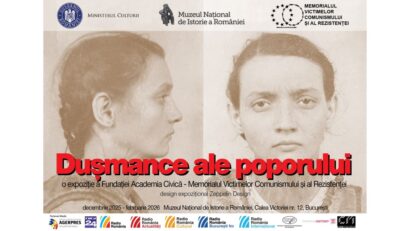SovromConstruction
Romanian-Soviet joint ventures were set up immediately after the Red Army occupied Romania, at the end of World War Two. Their label was ‘SovRoms, a complex term made of two words, of which one had the word Soviet as its root. The first such enterprise was Sovrompetrol, established on July 17, 1945. In theory, the SovRoms had been set up with the alleged purpose of rebuilding Romania and securing the payment of war damages to the USSR, funneling Romanian resources to the Soviet economy.

România Internațional, 18.04.2016, 12:56
Romanian-Soviet joint ventures were set up immediately after the Red Army occupied Romania, at the end of World War Two. Their label was ‘SovRoms, a complex term made of two words, of which one had the word Soviet as its root. The first such enterprise was Sovrompetrol, established on July 17, 1945. In theory, the SovRoms had been set up with the alleged purpose of rebuilding Romania and securing the payment of war damages to the USSR, funneling Romanian resources to the Soviet economy.
Romania’s incurring debt to the USSR at the time accounted for roughly 300 million US Dollars, yet according to some sources, Romania must have paid a lot more than that through the SovRoms. The Soviets’ contribution to setting up and running the SovRoms was feeble, their main asset being the Soviet advisers who supervised the activity of the enterprises.
However, the SovRoms had an additional role, that of involving the masses in Romania’s economic reconstruction. To that effect, ideology played a crucial role in recruiting the workforce. There was one enterprise around which this entire undertaking revolved: Sovromconstruction. Set up on July 4th, 1948, Sovromconstruction was responsible for the country’s large-scale building sites, where both skilled workers, as well as people who no longer complied with the communists’ demands, were sent as workforce.
One of the young men who at the time did not fit in ideologically was historian Dinu C. Giurescu, the son of historian Constantin C. Giurescu, a political prisoner. Fresh from the History Faculty in the 1950, Dinu C. Giurescu was sent to work as a supervisor with the Sovromconstruction road-building enterprise. In a 2002 interview to Radio Romania’s Center for Oral History, Dinu C. Giurescu explained how Sovromconstruction was born.
“The Sovromconstruction enterprise no. 6 specialized in road works, it took over Deutsche Rumanisches Bau, which was an interwar German-Romanian road construction joint venture. It was seized by the USSR after the armistice and, jointly with several other Romanian private small road construction enterprises forcibly seized by the state in 1948, it grew into the big Sovromconstruction enterprise number 6, a road construction company. And from February–March 1949 to early April, we had to take classes 6-7 hours a day, to learn the ropes of road building. All the people there, myself included, had profiles bordering illegality, people with a doubtful record. And then I was handed in my official assignment and I was dispatched to the Urziceni-Slobozia roadway, in the Andrasesti village.”
The young historian, whom the political criteria of the time prevented him from doing his job, had no choice other than to follow another career path and take a lower position as compared to his intellectual background. Life in the countryside and a proletarian environment were totally new for him.
“What I recall is that there was the main road, and the other roads of the village fell perpendicularly on that main road. I had rented a room from a villager living on a road bordered by poplar trees. It was the beginning of spring, the weather was nice and houses were still in a relatively good condition. From the main road to that house I had to walk 10 minutes on foot. And the adventure would start in the evening, when all dogs were barking and I was afraid they might come out of their yards. The supervisors had two wooden huts, hosting the so-called headquarters. At least half a day, if not more, I would stay on the construction site, walking to and fro along 10 km, to see what people were doing. I would speak to the team leaders, foremen, carrying out inspections. I recall a carpenter foreman, Constantin Dumitrescu, who was a quiet man, aged 40. I went to him saying I didn’t know anything about what they were doing and I asked him to teach me. And it was that foreman who taught me all about construction works. In a few days I learnt about all the elements of a wooden construction. Whenever they were doing something new, he was the man I would go to”.
Sovromconstruction, just like Sovromcoal, was an enterprise in which even the most undesirable could work, unlike other SovRoms, like Sovrombanc, Sovromfilm or Sovrominsurace, where professional development was decided by political criteria. Giurescu recalled, though, that he was well received by the less educated people at Sovromconstruction.
“Although I was from a different social category, people received me quite well. I’m not talking about office workers, because their world was a jungle in itself, in the sense that all those who had failed, from a social and political point of view, were there. They were former officers, former lawyers, magistrates, accountants. I remember Dumitrescu had been an officer in the Royal Guard. I had two reasons for concern. First of all, I didn’t want to cause any racket on the site, because some said they had been subject to wrongdoing and the Securitate, the political police, was in Urziceni and we all knew what that meant. My second fear was that I could be found doing something that had not been planned and which they could say I had decided myself, to make people look good. I didn’t see any of the Soviet councilors there. I think I only saw the director of Sovromconstruction 6, Habanov, once. I remember him wearing a large hat and suits with high shoulders and flared trousers, as the Soviet fashion dictated. All the others were engineers.”
Sovromconstruction, just like its other sister-enterprises, was dismantled between 1956-1959, as a sign of the Soviet leadership’s openness. However, animosities between Romania and the USSR over the SovRom assets lasted up until the 1980s.
(Translated by E. Nasta and M. Ignatescu)






























